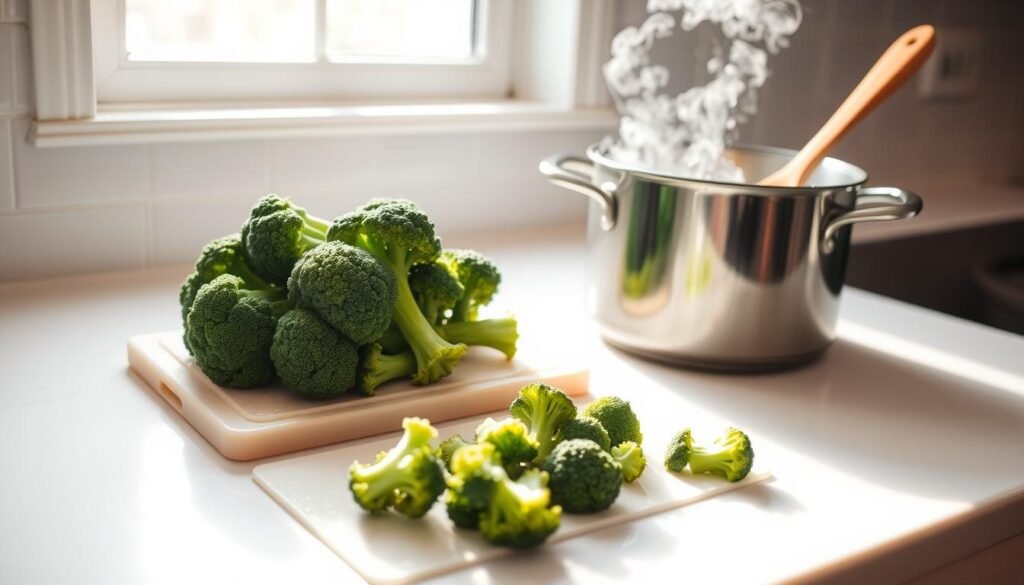Did you know broccoli is a superfood packed with nutrients? It gives you over 150% of your daily vitamin C in just one serving! This guide will teach you how to cook broccoli, covering its health benefits and cooking methods. It’s perfect for both experienced cooks and beginners, offering tasty broccoli recipes to enjoy.
Key Takeaways
- Broccoli is packed with vitamins, making it a nutritional powerhouse.
- Learning various cooking techniques enhances broccoli’s flavor and appeal.
- Fresh broccoli can be selected and stored to maintain its quality.
- Simple cooking methods like steaming and sautéing yield fantastic results.
- Mastering different ways to include broccoli in your meals can bring health benefits.
The Nutritional Benefits of Broccoli
Broccoli is a versatile vegetable known for its nutritional benefits. It’s full of vitamins and minerals that are good for our health. Broccoli makes our meals better and helps us stay healthy in many ways.
Packed with Vitamins and Minerals
Broccoli is full of important nutrients. It has vitamins C and K, folate, and potassium. These nutrients help our bodies work well and keep us healthy.
Vitamin C boosts our immune system. Vitamin K helps our bones stay strong. So, broccoli is a great choice for our diet.
Rich in Antioxidants
Broccoli has antioxidants that protect our bodies. These antioxidants fight off stress and inflammation. Eating broccoli helps lower the risk of chronic diseases.
When I eat broccoli, I know I’m getting its health benefits. Its antioxidants are key to staying healthy.
A Great Source of Fiber
Broccoli is also high in fiber. Fiber helps with digestion and keeps us full. It makes our meals more satisfying and supports our digestive health.
The benefits of broccoli go beyond just nutrition. It helps us feel our best and promotes a balanced diet.
Choosing the Right Broccoli
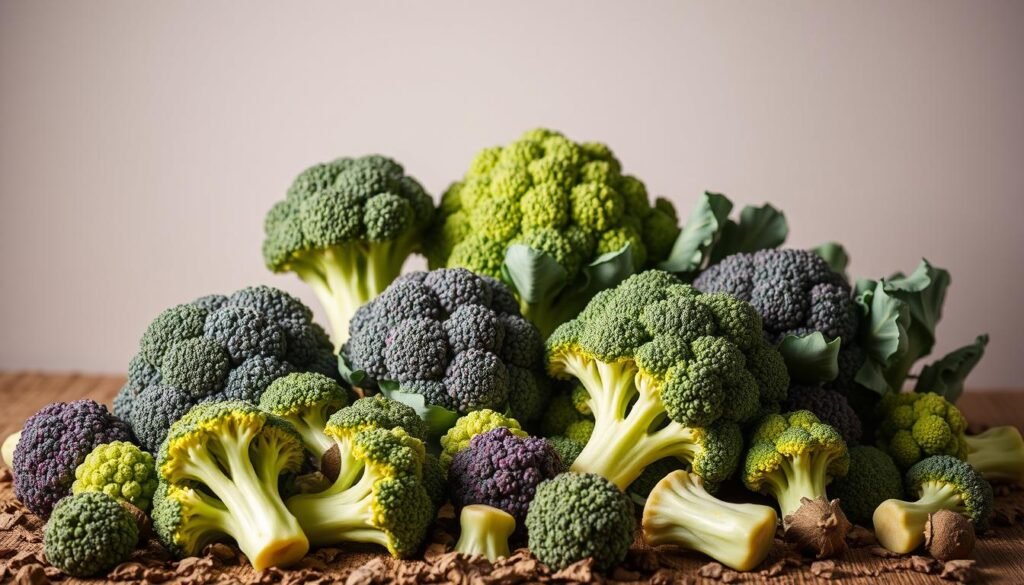
Broccoli comes in many types, and picking the right one can make your meals better. You can find Calabrese, broccolini, and even purple cauliflower. Each type has its own taste and texture, perfect for different dishes. Here are some tips to help you pick the freshest broccoli.
Types of Broccoli
The most well-known types of broccoli are:
- Calabrese Broccoli: The classic variety with thick stalks and green florets.
- Broccolini: A mix of Chinese broccoli and traditional broccoli, tender with a sweet taste.
- Purple Cauliflower: Has the same taste as broccoli, but with vibrant color and nutritional benefits.
How to Select Fresh Broccoli
When picking fresh broccoli, look for these signs of quality:
- Choose heads that are a vibrant green color.
- Florets should be tightly packed and firm to the touch.
- Avoid any yellow spots or wilting leaves, as these indicate age.
Storage Tips for Freshness
After picking the right broccoli, it’s important to store it properly:
- Keep broccoli in the refrigerator, ideally in a perforated plastic bag.
- Avoid washing it until ready to use, as moisture can promote decay.
- Properly stored, it can last for about three to five days.
Preparing Broccoli for Cooking
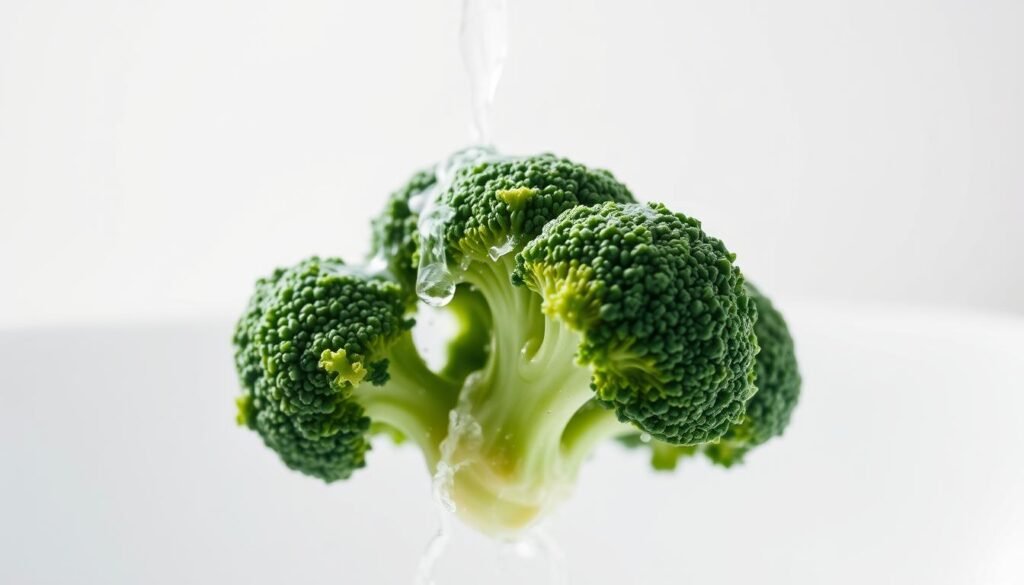
Getting broccoli ready right makes it taste better and keeps its health benefits. First, I wash it to get rid of dirt and chemicals. Then, I cut it to make it perfect for cooking.You can learn more about how to cook rice.
Washing and Cutting Techniques
I rinse broccoli florets under water, shaking them gently to remove dirt. When cutting, I make sure the florets are all the same size. This size helps them cook evenly, making every bite great.
Removing Tough Stems
It’s key to remove the hard parts of the stem. I cut off the tough outer layer. The inside is usually soft and can be sliced thin to add to the florets. This way, we use every bit of the veggie.
Prepping for Different Cooking Methods
Each cooking method needs a special way to prepare broccoli. For steaming, I leave the florets whole. For roasting, I cut them smaller to get a nice brown color. Knowing these tricks lets me enjoy broccoli in many dishes.
Cooking Broccoli: Simple Methods to Try
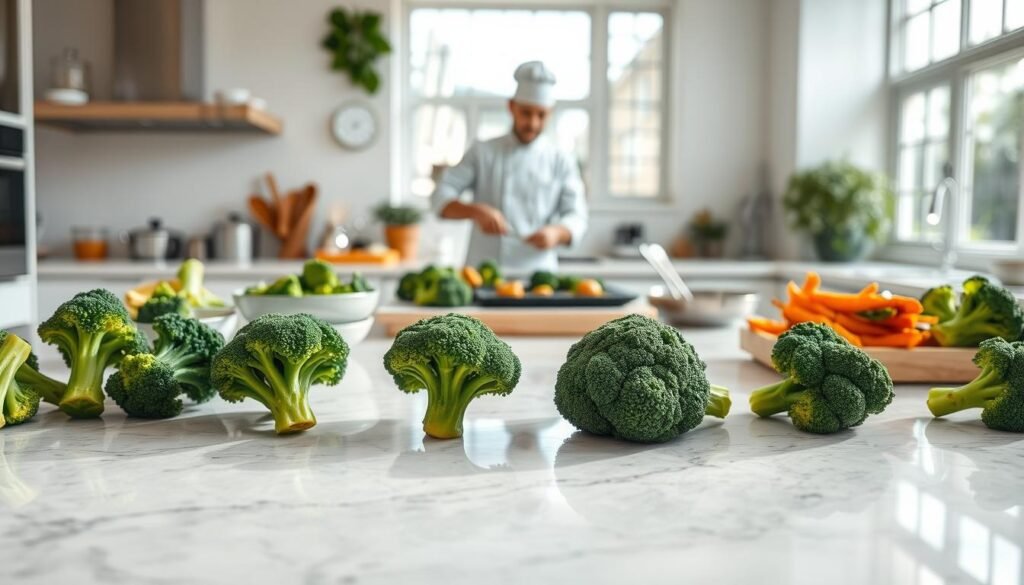
There are many ways to cook broccoli, each with its own perks. Whether I’m in a rush or cooking for a special occasion, steaming, boiling, and microwaving are my top choices. Let’s explore each method’s benefits.
Steaming Broccoli
Steaming broccoli keeps it green and full of nutrients. I use a steamer basket over boiling water for 5-7 minutes. This way, the broccoli stays tender but crisp, enhancing its taste and health.
Boiling Broccoli
Boiling broccoli is quick, taking just 3-5 minutes. I watch the time closely to avoid overcooking. It’s best to remove the broccoli when it’s bright green but still crisp.You can learn more about how to cook asparagus.
Microwaving Broccoli
Microwaving broccoli is fast, taking only 2-3 minutes. I put the broccoli in a microwave-safe bowl with a bit of water, cover it, and microwave on high. This method steams the broccoli in its own moisture, saving time and preserving flavor.
Roasting Broccoli: A Flavorful Option
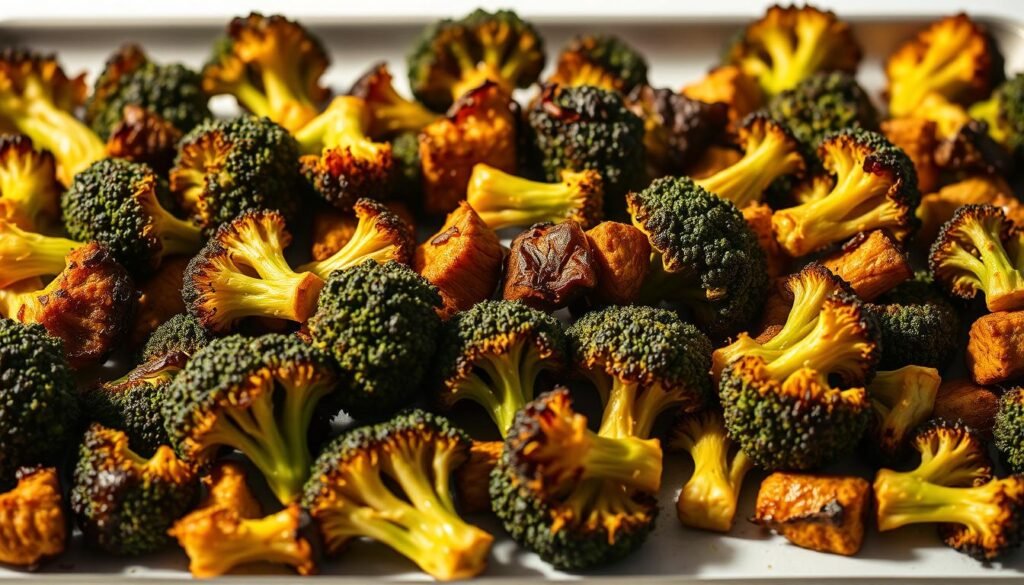
Roasting broccoli makes it sweet and crunchy. This method boosts flavor and offers many benefits. It turns even the most skeptical eaters into broccoli lovers.
The Benefits of Roasting
Roasting broccoli improves its taste. The heat caramelizes the sugars, making it taste nutty. It keeps more nutrients than boiling. A well-roasted batch can be a great side or main dish.
Seasoning Ideas for Roasting
I toss broccoli in olive oil, salt, and pepper for flavor. Adding minced garlic or chili flakes gives it a kick. Try parmesan, lemon zest, or soy sauce for different tastes. Mixing up seasonings can make roasting broccoli exciting.
Optimal Cooking Times for Perfectly Roasted Broccoli
For perfect broccoli, roast at 425°F. Cook for 20 to 25 minutes for tender inside and crispy edges. Halfway, toss it for even cooking. Watch it closely to preserve flavor.
| Cooking Temperature | Cooking Time | Seasoning Suggestions |
|---|---|---|
| 425°F | 20-25 minutes | Olive oil, garlic, chili flakes |
| 425°F | 20-25 minutes | Parmesan, lemon zest, soy sauce |
Sautéing Broccoli for Quick Meals
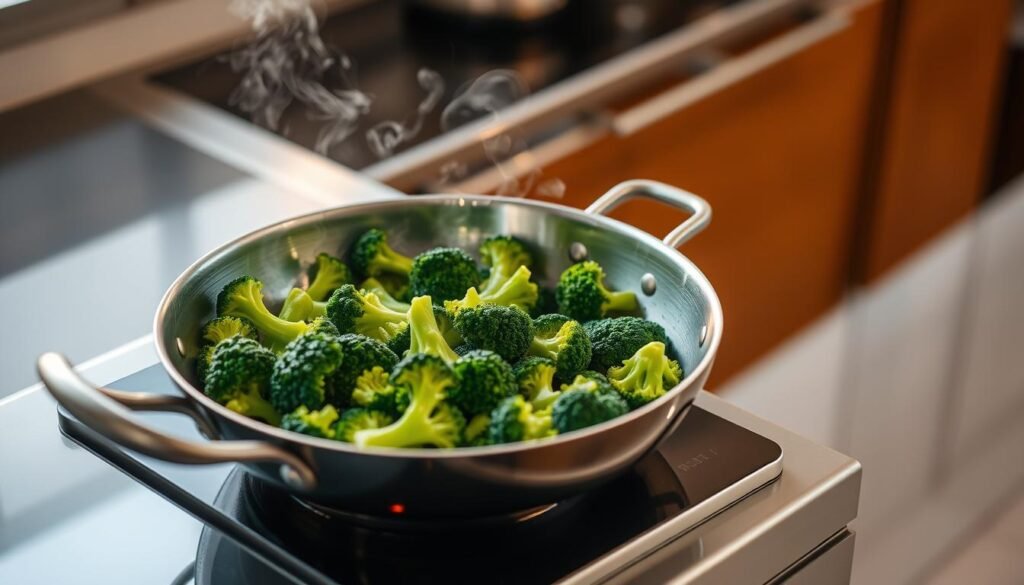
Sautéing broccoli is a favorite cooking method of mine. It makes quick, tasty meals that are good for you. With a few ingredients, I can make a vibrant dish in under 15 minutes. It’s great for busy weeknights.learn more about how to cook corn on the cob
Best Oils and Seasonings for Sautéing
I often use olive oil or butter to sauté broccoli. They add great flavor and make the broccoli golden. Adding minced garlic gives it a nice aroma. A bit of lemon juice or salt and pepper can make it even better.
Cooking Techniques for Sautéed Broccoli
To sauté broccoli right, I heat oil in a skillet over medium heat. Then, I add broccoli florets and cook until they’re crisp-tender and green. This takes about 5-7 minutes. It keeps the broccoli’s nutrients and adds a nice crunch.
If I want to try something new, I might add Parmesan cheese. It makes a simple side dish or main course.
Broccoli in Soups and Stews
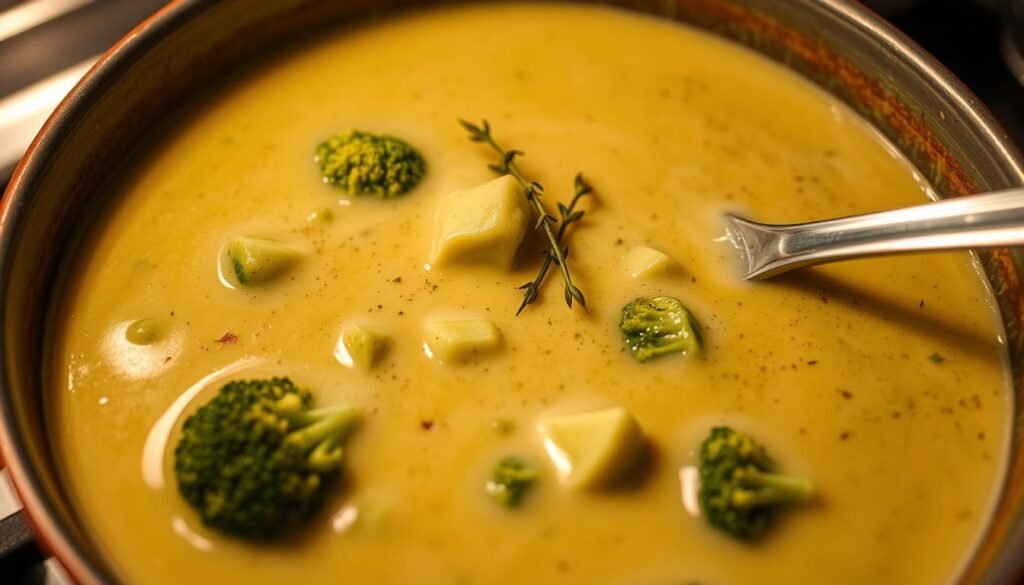
Adding broccoli to soups and stews is a great way to boost nutrition and flavor. This green veggie can make your meals healthier and tastier. It’s perfect for adding color and texture to any dish.
Adding Broccoli to Classic Soups
Broccoli is a great addition to vegetable soups. I add chopped broccoli for the last 10 minutes to keep it tender. It pairs well with carrots, potatoes, and herbs for a hearty meal.
This is a simple way to make your broccoli soup recipes better.
Blending for Creamy Broccoli Soup
For a cozy meal, I make creamy broccoli soup. I steam broccoli, then blend it with broth. Adding cream or milk makes it creamy.
A bit of garlic, onion, and nutmeg can make it even better. For a detailed recipe, check out this creamy broccoli soup recipe. It’s great for meal prep or a quick warm-up.
Creative Broccoli Salad Recipes
Broccoli salads are a vibrant and nutritious way to enjoy this superfood. They come in many flavors and are perfect for any occasion. Exploring broccoli salad recipes can add excitement to your meals.
Classic Broccoli Salad
The classic broccoli salad is a favorite. It has fresh broccoli, crispy bacon, and shredded cheese, all mixed with a sweet dressing. It’s not only delicious but also has a great crunch. I make it for gatherings because it’s loved by everyone.
Asian-Inspired Broccoli Salad
I love making an Asian-inspired broccoli salad. It uses sesame oil and soy sauce for a unique taste. Sliced almonds add a nice crunch. A drizzle of rice vinegar makes it refreshing. It’s a standout dish for parties.
Broccoli Slaw Variations
Making broccoli slaw is easy and fun. It’s a colorful salad with a tangy dressing. By adding carrots and red cabbage, it becomes both beautiful and healthy. It’s great for picnics or as a side at barbecues and stays fresh in the fridge.
Trying out different broccoli salad recipes is always a success. For more ideas, check out this resource.
Incorporating Broccoli in Pasta Dishes
Broccoli can make ordinary pasta dishes into healthy meals. I enjoy trying different recipes that mix pasta with this nutritious veggie. Broccoli Alfredo and Broccoli Pesto Pasta are my go-to dishes. They taste great and add important nutrients, making sure I eat broccoli without losing flavor.
Broccoli Alfredo Recipe
To make tasty broccoli Alfredo, I steam the broccoli florets lightly. Then, I mix them with cooked fettuccine and creamy Alfredo sauce. This dish is comforting and adds a healthy twist to a classic. The flavors in this recipe really stand out.
Broccoli Pesto Pasta
Broccoli Pesto Pasta is another favorite of mine. I blend cooked broccoli with basil, garlic, olive oil, and nuts to make a vibrant sauce. Adding this pesto to pasta makes the dish even better. Using broccoli boosts the flavor and adds nutritional value. For more broccoli pasta ideas, see this resource.
| Recipe | Main Ingredients | Cooking Time |
|---|---|---|
| Broccoli Alfredo | Fettuccine, broccoli, Alfredo sauce | 20 minutes |
| Broccoli Pesto Pasta | Pasta, cooked broccoli, basil, garlic, olive oil, nuts | 15 minutes |
These pasta dishes show how easy it is to add broccoli to meals. Don’t be afraid to try these broccoli pasta recipes. They might become your new favorites!
Freezing Broccoli for Later Use
Freezing broccoli is a great way to keep its nutrients and taste. It lets me enjoy this healthy veggie even when it’s out of season. Just follow a few easy steps for the best results.
Blanching Before Freezing
Blanching broccoli is key before freezing. Boiling it in salted water for three minutes stops enzymes that can ruin its flavor and color. Then, I cool it down fast in an ice bath to stop cooking.
After cooling, I dry it well to avoid ice crystals. This step is vital for how to freeze broccoli right.
Storing Frozen Broccoli
When the broccoli is ready, I lay it out on a tray and freeze it for three hours. Then, I put it in zip-top bags or airtight containers. This way, it stays fresh for 6-8 months.
For more on freezing broccoli, check out this resource. To use it, just roast it in a hot oven for 15 to 20 minutes. It adds a tasty touch to any meal.
Common Mistakes to Avoid When Cooking Broccoli
When cooking broccoli, it’s key to avoid common mistakes. Overcooking and not enhancing the flavor are two big ones. Knowing how to avoid these can make a big difference.
Overcooking: How to Prevent It
Overcooking broccoli can make it mushy and lose its color. To keep it green and crisp, I follow these tips:
- Keep an eye on the cooking time. For steaming or boiling, I use a timer.
- Check the broccoli with a fork a minute or two before it’s done. It should be tender but still firm.
- Use an ice water bath after cooking. This stops the cooking and keeps the color bright.
Avoiding Flavorless Broccoli
Another mistake is not making broccoli flavorful. A bit of salt or olive oil can make a big difference. Here’s how I do it:
- Add garlic or onion while cooking for extra flavor.
- Try different herbs and spices to find what you like. Lemon zest or red pepper flakes can really change the taste.
- Top the broccoli with cheese or a nut-based sauce for a fun twist.
Conclusion: Enjoying Broccoli in Your Meals
Broccoli is packed with nutrients and can be used in many ways. I love steaming, roasting, or sautéing it. Its unique taste and bright green color always catch my eye.
Adding broccoli to my meals helps me get essential vitamins and minerals. It also lets me try out different cooking styles.
Getting my family to like broccoli is easier with fun recipes. We’ve tried family-friendly broccoli recipes, salads, and soups. Making it together is a great way to bond and enjoy healthy food.
Broccoli has become a staple in our home, promoting healthier eating. It’s exciting to see how versatile it is. Let’s explore more ways to make broccoli a part of our meals!


